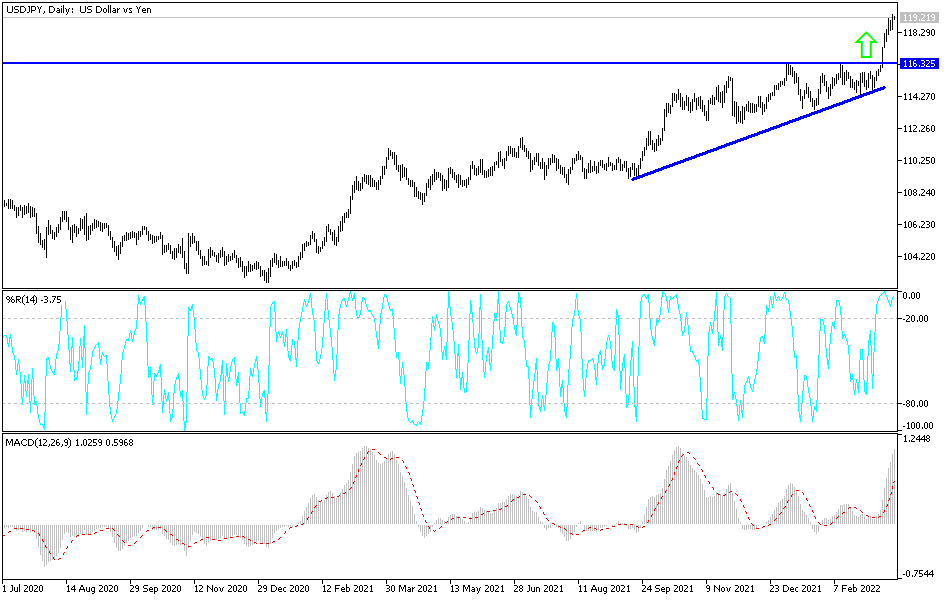The Japanese yen collapsed a lot against the rest of the major currencies and against the US dollar, with losses that pushed the price of the US dollar pair against the Japanese yen USD/JPY towards the 119.39 resistance. It closed the week’s trading near it, as the pair’s gains are the highest in five years. The Japanese yen's decline came as investors combed through the US central bank's latest monetary policy decision. Tokyo is experiencing tepid economic growth, along with rising price inflation. Nevertheless, the Bank of Japan (BoJ) left the benchmark short-term rate at -0.1%, which was widely expected by market analysts. The negative rate has remained the same since 2016.
Central Bank of Japan Governor Hirohiko Kuroda has predicted that the Ukraine crisis will affect many components of the world's third largest economy, especially regarding inflation. “The biggest impact on the Japanese economy from the Ukraine crisis is the rise in raw material costs,” he said. Japanese inflation is likely to accelerate significantly for the time being. But it also weighs on the economy from a long-term perspective by lowering corporate profits and household real income.”
That will depend on future crude oil price movements and government steps to cushion the blow. But we can see inflation moving around 2% for some time from April. Higher costs will lead to higher inflation. But it weighs heavily on households and corporate profits, and could have a negative impact on Japan's economy. We will patiently maintain strong monetary easing to achieve sustainable and stable inflation.”
The BoJ's pessimistic stance is very different from that of the Federal Reserve and the Bank of England (BoE), two institutions that raised interest rates to curb inflation.
On the economic side, according to the Japanese government, annual inflation rose 0.9% in February, up from a reading of 0.5% in January. Core inflation advanced 0.6% year-on-year last month, in line with market expectations. On a monthly basis, the Consumer Price Index (CPI) rose 0.4%, up from 0% in January. Among other economic data, Japanese industrial production fell 0.8%, machinery orders fell 2%, and capacity utilization contracted 3.2%.
Japanese trade data was mixed in February. Where imports grew 34%, above market expectations of 28%. Exports rose 19.1%, below the average estimate of 21%.
The fading strength of the US dollar confirms the suspicions of some analysts that the market has effectively satiated expectations of a rate hike from the Federal Reserve, thus providing diminishing returns to dollar bulls. Commenting on this, Valentin Marinov, Forex Analyst at Credit Agricole says, “The US dollar is still the king of the high-yield and safe haven G10. However, price action following the March FOMC meeting highlighted that there are limits to which the increased interest rate advantage can support the US dollar across the board.”
Meanwhile, some analysts point to a historical tendency for the US dollar to fall after the first rate hike in the Fed's raising cycle. Accordingly, Adam Cole, FX analyst at RBC, said: “A worn market axiom, which says selling the US dollar at the first Fed rate hike, is trading with additional momentum after the US dollar failed to rally in the wake of last week’s FOMC optimism.”
According to the technical analysis of the pair: So far, the general trend of the USD/JPY pair is still bullish. At the same time, it is worth noting and emphasizing that the recent gains of the USD/JPY pair moved the technical indicators towards overbought levels, unless the US dollar gains more momentum. Profit-taking may be activated at any time. This is expected strongly, especially after the storm of US interest rate decisions has passed from the US Federal Reserve.
According to the performance on the daily chart, breaking the current trend requires moving towards the support levels 117.35 and 116.20, respectively. Otherwise, the bulls' control will remain in place for some time.

